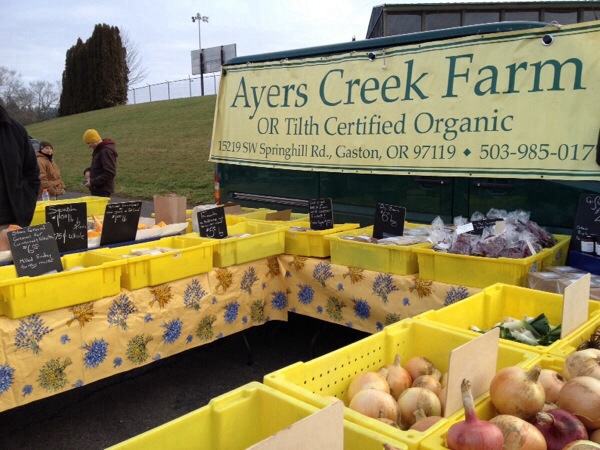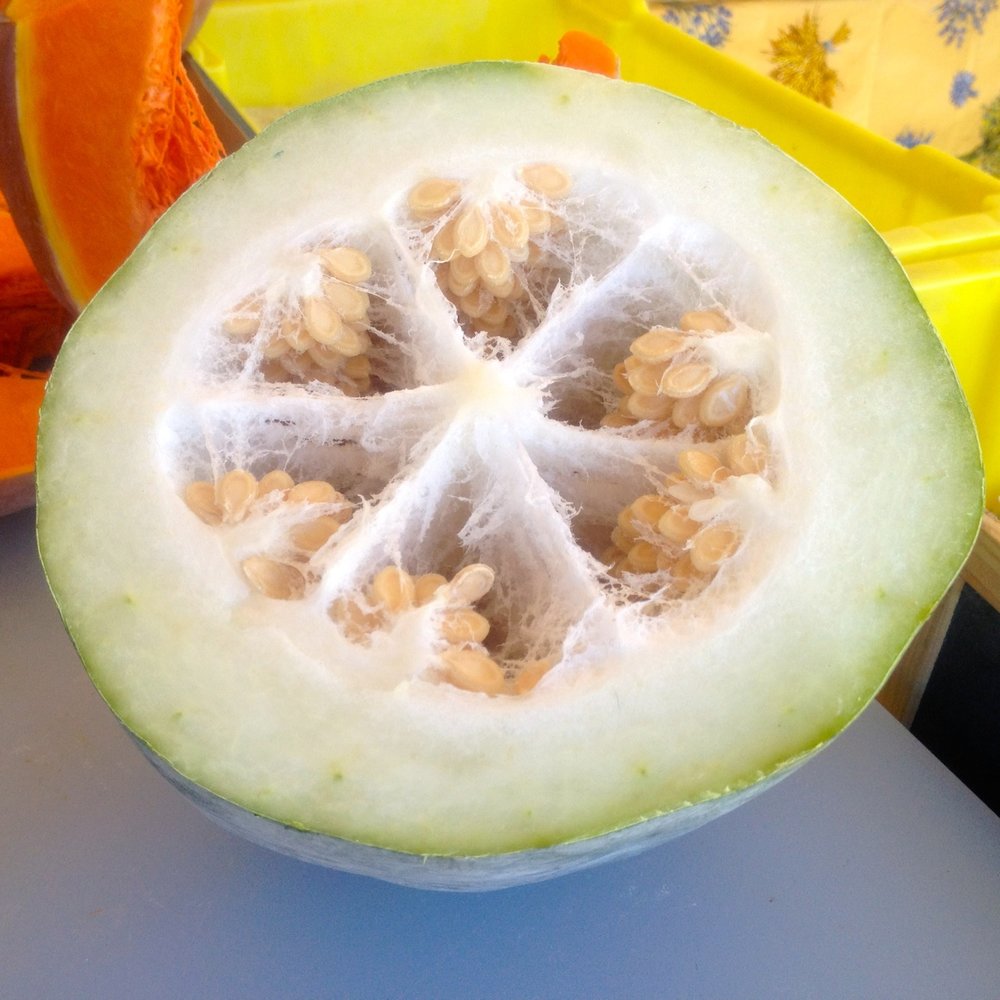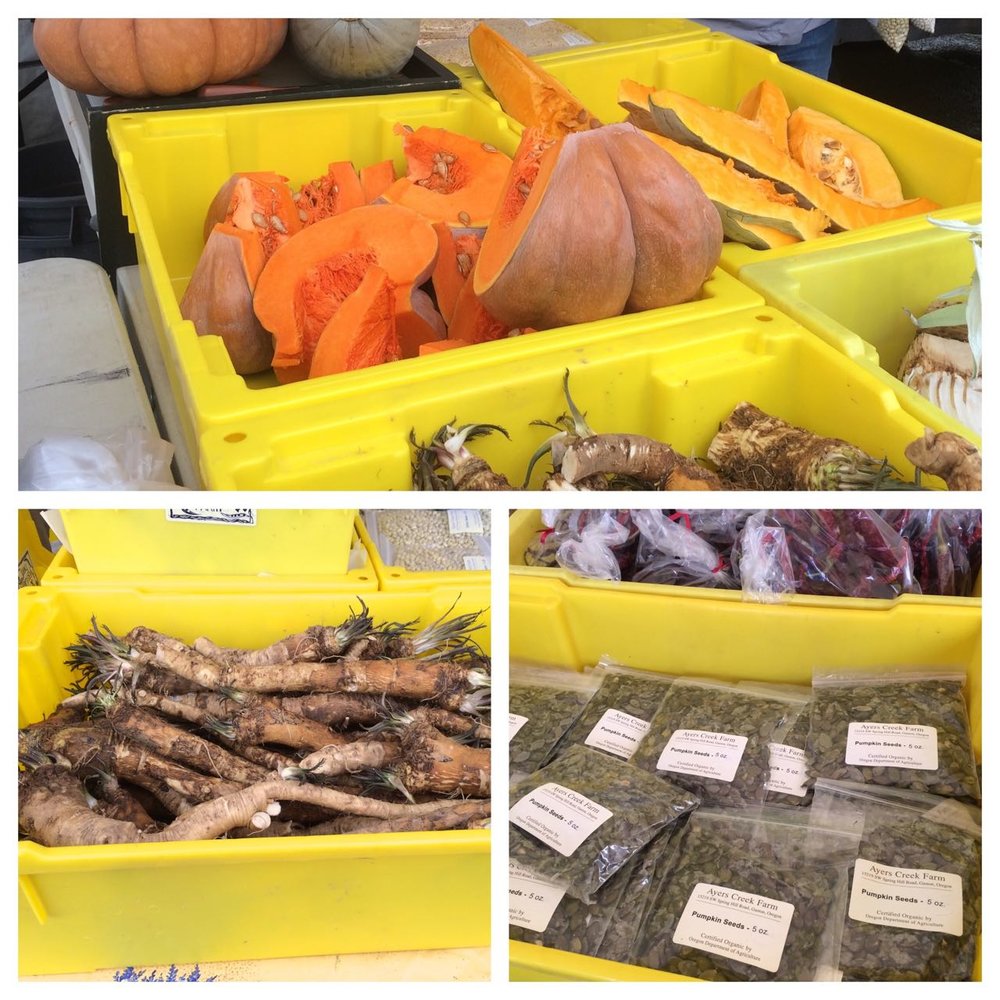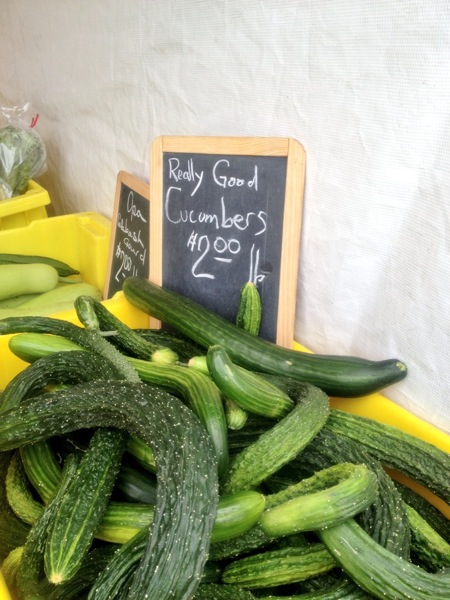As you tuck deeper into your covers knowing the alarm clock has its day off, you can take comfort knowing that a farmer and his daughter will rise in the still dark and frosty fog, and have things arranged nicely for Hillsdale Farmers' Market opening bell at 10 AM.
Here is what we will bring:
Dry beans and cayenne peppers, winter squash, sweet potatoes, spuds, onions, ash gourds, preserves, popcorn and cornmeal.
For those who have eyed the ash gourd, or more aptly winter cucumber, with reservations, Katherine Deumling of "Cook with What you Have" (www.cookwithwhatyouhave.com) has prepared a recipe for a flavorful, refreshing salad using the gourd. We will have a recipe sheet available at the market.
____________________________________________________________
For several years, our 15-acre berry field produced approximately 15% of the nation's organic blackberries. We sold roughly 200,000 pounds of berries annually to Cascadian Farm, and they were packaged and sold all across the country. The organic sector has grown tremendously since then, and today our production would fall several zeros on the right of the decimal point, but it was significant at the time. As our field aged, we decided to shift the focus of our farm. Nonetheless, those first seven years taught us a lot about farming and working with a large staff.
About 18 months ago, two blueberry growers had shipments of their blueberries blocked until they admitted they violated labor laws and signed consent judgements. As a relatively small direct sales farm operation, it is tempting to brush off the case as a matter affecting only big farmers, an event beyond our ken. On the other hand, the case represented a terrible miscarriage of justice from a farmer's perspective. Preventing the sale of a perishable crop and using its very perishability to exact a binding confession is wrong, and fortunately, as reported in the Oregonian yesterday, a U.S. Magistrate has sided with the growers with respect to the consent judgement.
During our Cascadian seasons, we had a large staff harvesting fruit. Consistent with the law, we paid staff a price per pound of fruit picked or minimum wage, whichever was greater. Harvesting berries is skilled work and there is a great disparity between the fastest and slowest pickers. Two of our very best berry harvesters, Gregorio and Leticia, would typically bring in 300 to 350 pounds of berries a day early in the season. Gregorio was 80 years old, and Leticia was 22. Both of them picked with an easy precision, just like the finest typists their fingers moved without a wasted motion or mistake. On the other end of the spectrum, we had pickers who struggled to bring in 150 pounds during the same period, and a good number who never reached 100 pounds. The slowest staff always earned minimum wage, whereas the fastest would earn well over $20/hour, especially early in the season.
The complaint against the blueberry growers asserted that they allowed "ghost workers." This was determined by the average the picking staff harvested in a month and people who picked more than the average were assumed to be assisted by another worker who was not submitting their own harvest tickets. Reading the paper, we were struck by the fact that Gregorio and Letica, both highly skilled solo pickers, who would have been considered by the Department of labor as two or three people under the agency's formula. There was nothing ghostly about their skill. Treating harvesting of fruits and vegetables as unskilled work where everyone should pick at the same rate because any idiot can pick a berry or apple, the assumption behind the purely statistical investigation, degrades the workers' value. It is also a gross misuse statistics.
It is true that in any larger harvest operation, there will be some "ghost workers." Often a brother, sister or spouse will help if they don't have work one day. When there are 100 people in the field, an out-of-place person is not easy to discern, especially a close relative. There are also compelling ghosts. We had one couple who would pick together for an hour before the husband, who drove his wife to the farm, would leave to work at a nursery up the road. Another man drove his wife to work and slept in the car until noon or so because he worked as custodian cleaning offices all night, and after waking he would help her haul her flats of berries out of the field. A mother of one of our staff would show up at 11:30, sell tamales and tacos from the back of her car, and then help her son for an hour or so. No one was gaming the system; it was the way the agricultural families helped each other.
One year, we had to harvest the field on Labor Day because of rain expected later in the week, and so many family members who had the day off came to help each other that we were done by 9:30. That day, there were more ghosts than staff, but the family member on the payroll was paid for every berry brought to the scale and punched on their ticket; there was nothing spectral about the dollars they earned. They got the job done early and enjoyed the rest of Labor Day together.
There are real problems with growers shorting and mistreating their harvest staff, but growers should retain the right to challenge the evidence brought against them, especially evidence as flimsy and tenuous as the statistical models employed by the Department of Labor. Maybe the blueberry growers in this case are bad actors, however as farmers who have faced similar challenges in the field we believe a reasonable doubt exists and a day in court is warranted. Just as there are bad and sloppy farmers, there are bad and sloppy inspectors. Inspectors wield tremendous power and it takes a great deal of discipline to keep an inspection from cascading into an adversarial encounter. When a farmer has been up and dealing with a host problems since the break of day, seeing a fresh, perky suit show up late in the morning during the busiest part of the season, coffee in hand, for an unannounced inspection foretells a missed lunch and a ruined afternoon. Equanimity can be elusive.
Running any sort of farm is challenging and the shrinking availability of labor and the perils of dealing with the thicket state and federal laws convinced us to shift how we farmed. The way the field operates today is more cerebral than sensuous, gone are the sounds of laughter and exchange of gossip, the tinny transistor radios, the rhythmic calling of the weight and the click as the tally card is punched, and the dense fragrance 20,000 pounds of Chesters loaded on the big flatbed and ready to go to the processor in Salem. We harbor no nostalgia, but retain a healthy respect for those who farm as we did seven years ago. It is a hard business, and they deserve fair treatment by government agencies.
We will see you all Sunday,
Carol & Anthony Boutard
Ayers Creek Farm















 though now surrounded by an ever-encroaching suburbia. The land was never farmed by his family, rather they leased it out in parcels to nearby growers for cutting hay, grazing animals or growing strawberries.
though now surrounded by an ever-encroaching suburbia. The land was never farmed by his family, rather they leased it out in parcels to nearby growers for cutting hay, grazing animals or growing strawberries. From the beginning, Ed had the intention of selling the best apples he could produce. To ensure their quality of flavor and market value, he worked toward organic certification while his trees matured. Within two years Ed was bringing his fruit to markets in the Vancouver, WA area.
From the beginning, Ed had the intention of selling the best apples he could produce. To ensure their quality of flavor and market value, he worked toward organic certification while his trees matured. Within two years Ed was bringing his fruit to markets in the Vancouver, WA area. Elstar, a variety developed in the Netherlands, has soft flesh with an effervescence that hits the tongue then quickly fades into a hint of sweetness. Ed calls these his “champagne apples” because of their unique flavor profile.
Elstar, a variety developed in the Netherlands, has soft flesh with an effervescence that hits the tongue then quickly fades into a hint of sweetness. Ed calls these his “champagne apples” because of their unique flavor profile.






